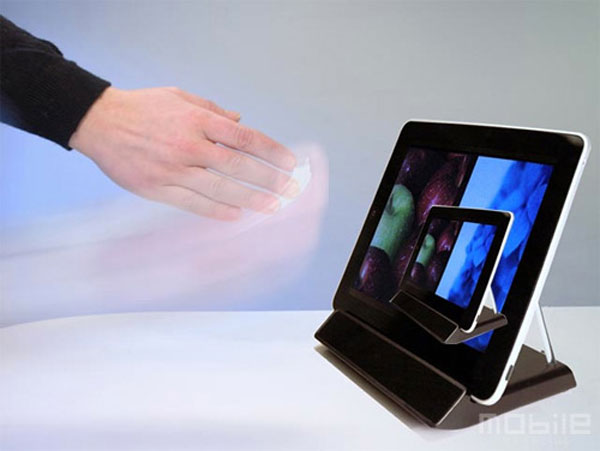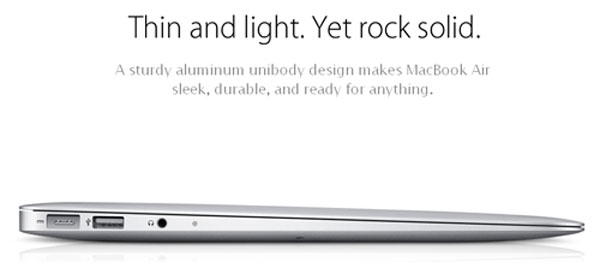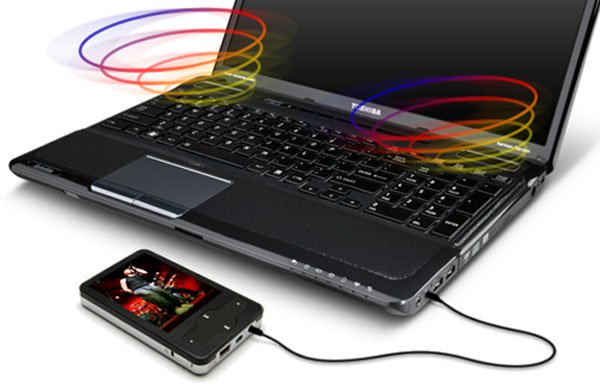New, interesting technologies on laptops
3D technology does not need glasses, motion detection or phone charging and listening to music through a laptop even when the device is turned off is very interesting.
In addition to yearly upgrade or new connectivity standards such as Bluetooth 4.0 and USB 3.0, recent laptops are all equipped with some interesting technologies to better serve the needs of users. These technologies have all been used in specific products to be marketed, while others such as transparent screens are only in test and demo versions.
Here are some interesting new technologies on laptops today.
3D technology without glasses

Laptop 3D without glasses is quite new in the country. (Photo: Tuan Hung).
Two years after the first 3D laptop sold in Vietnam, a new development of the hologram on the laptop appeared. Glassless 3D technology has been available on TV lines since last year but only appeared 3 months ago on laptops. The first model in the world equipped with this technology, Toshiba's Qosmio F750 has started selling in Vietnam since early October.
3D technology without glass helps users to view holograms directly on the screen without adding accessories. However, the disadvantage of this technology is faster eye fatigue than conventional 3D technology and only optimized for one to two users to monitor because the machine needs to calculate the user's perspective to provide a visual display plan. be suitable.
Just like on TV, 3D technology in general and 3D without glasses in particular are not really popular in Vietnam because the price is much higher than the average income and limited content supply.
Motion recognition

Control by hand movement. (Photo: Tuan Hung).
Microsoft Kinect blew a new wind into the way users control technology devices. Instead of using a control device, the owner just needs to use gestures to dictate the machine or play games.
On laptop models, this technology is also gradually being applied. Sony has now introduced motion recognition to new Vaio laptops or the recent Vaio L series. However, the motion recognition still stops in the "primitive " form like waving back and forth to control the image viewer, transferring songs . The motion recognition is performed by the webcam located on the side. before. This technology will be upgraded soon.
Super thin fabrication

Laptops are getting thinner and the price is cheaper.
Slim is probably a more natural word for design but hidden in computers like Apple's MacBook Air, Samsung Series 9, Toshiba Portégé Z830 or newly launched ultrabooks that are superior to those produced by years ago. By arranging and using new boards, processors, and solid-state drives, these models offer amazing thinness like the 17-inch MacBook Air at the thickest point. Not only that, an ultra-thin laptop 2 to 3 years ago like the Dell XPS costs up to 2,000 to 3,000 USD but now for just over 1,000 USD, users can own an ultra-thin laptop, super mobile.
The downside of these slim designs is that there is usually no optical drive attached, limiting the connection port, making it harder to escape heat because the space in the machine is confined. The slim design also makes it necessary for the machines to have a stronger structure to prevent breakage and damage during impact. Therefore, aluminum is now the only material to make ultra-thin laptops thanks to its durability and good heat-release ability.
Charge when the device is off
An integration sounds small but is very convenient for many users. Sleep & Charge helps users to charge for mobile devices even when the device is turned off via a USB port that incorporates this technology.
This is very convenient for travel, business or car trips, users can charge the music player or mobile over the laptop's source. This technology is currently used by Toshiba in some models such as R830, R840 for entrepreneurs.
Listen to music when the device is turned off

Listen to music via MP3 player with laptop speakers.
Sleep & Music is another interesting feature taking advantage of the laptop's speakers even when the device is off. Users can connect MP3 music devices such as iPods and phones to laptops via a cord with two ends, all 3.5 mm. The laptop's speakers will play music but have a slightly smaller volume than when using the device on.
This technology currently has quite a few laptop models used, mainly Toshiba with models like NB520, X770, P750 to take advantage of Harman / Kardon brand speaker system.
You should read it
- Huawei's fast charging technology surpasses Apple and Samsung
- Steps to fix charging laptop not to power
- It's time to face the 'reverse side' of face recognition technology
- New face recognition technology can identify objects up to 1,000 meters away
- 15 great benefits of listening to music you may not know
- Advantages and disadvantages of charging the phone battery with a laptop?
- Overnight charging laptop exploded a corner of the office
- Fingerprint recognition will land on Windows Phone 8.1
May be interested
- Fret select LCD screen - CRT
 it is a fierce competition between one side and new technologies that are constantly developing and on the one hand are old but not backward technologies.
it is a fierce competition between one side and new technologies that are constantly developing and on the one hand are old but not backward technologies. - Pray for blessing for healthy laptops
 first of all, it must be recognized that the japanese are very famous for their trendy technologies. however, few people know their technology equipment is prayed completely.
first of all, it must be recognized that the japanese are very famous for their trendy technologies. however, few people know their technology equipment is prayed completely. - What is DLP? Top Popular DLP Tools and Technologies
 dlp (data loss prevention) is a set of solutions, strategies, processes, and technologies to protect sensitive data from being lost, stolen, accessed without authorization, or misused.
dlp (data loss prevention) is a set of solutions, strategies, processes, and technologies to protect sensitive data from being lost, stolen, accessed without authorization, or misused. - Top 5 best Lenovo laptops 2021
 since 1984, lenovo has been producing affordable, reliable laptops for business and creative professionals. this brand supplies laptops for every need, with a variety of screen sizes, processors, audio technology, screen resolutions and security features available.
since 1984, lenovo has been producing affordable, reliable laptops for business and creative professionals. this brand supplies laptops for every need, with a variety of screen sizes, processors, audio technology, screen resolutions and security features available. - Top 5 high-end laptops 2020 running well with graphics and gaming
 laptops for graphics and games must invest in high-end machines with strong performance. the manufacturers also often divide gaming laptops, laptops that specialize in design. the options are 'huge' enough to balance both the graphics and the following gaming that are not easy to find.
laptops for graphics and games must invest in high-end machines with strong performance. the manufacturers also often divide gaming laptops, laptops that specialize in design. the options are 'huge' enough to balance both the graphics and the following gaming that are not easy to find. - Future smartphone battery technologies
 with the speed of smartphone development and accompanying applications are growing rapidly. however, it seems that the development of batteries has not kept up when they still require users to plug in the charger regularly. one signal for us is that scientists are working on the latest technologies to increase the life time and battery life of smartphones. please refer to the following technologies.
with the speed of smartphone development and accompanying applications are growing rapidly. however, it seems that the development of batteries has not kept up when they still require users to plug in the charger regularly. one signal for us is that scientists are working on the latest technologies to increase the life time and battery life of smartphones. please refer to the following technologies. - 10 laptops 'unforgettable'
 laptops are gradually becoming an indispensable device for users today. the following are the laptops that have recorded an extremely deep mark on the technology market.
laptops are gradually becoming an indispensable device for users today. the following are the laptops that have recorded an extremely deep mark on the technology market. - Top 7 best gaming laptops in 2021
 to help you find the best gaming laptop available right now, tipsmake has compiled a list of the best models that both meet your learning needs and combine entertainment with high flexibility. these gaming laptops will be the perfect choice.
to help you find the best gaming laptop available right now, tipsmake has compiled a list of the best models that both meet your learning needs and combine entertainment with high flexibility. these gaming laptops will be the perfect choice. - World popular technologies thanks to Apple
 not a pioneering company, but apple can turn interesting ideas still into the market into mainstream technology and put competitors in pursuit.
not a pioneering company, but apple can turn interesting ideas still into the market into mainstream technology and put competitors in pursuit. - 40 interesting facts you didn't know about the Sun.
 after reading the interesting facts about the sun below, you will surely be surprised at our star as well as the ancient races. let's take a look at 40 interesting facts about the sun you may not know yet!
after reading the interesting facts about the sun below, you will surely be surprised at our star as well as the ancient races. let's take a look at 40 interesting facts about the sun you may not know yet!










 Outstanding laptop 2011 according to each criterion
Outstanding laptop 2011 according to each criterion Netbooks are increasingly selling slowly in Vietnam
Netbooks are increasingly selling slowly in Vietnam Acer increased Aspire S3 ultrabook configuration to compete MacBook Air
Acer increased Aspire S3 ultrabook configuration to compete MacBook Air MacBooks can come back using Nvidia chips
MacBooks can come back using Nvidia chips CES 2012 event will be the festival of Ultrabook
CES 2012 event will be the festival of Ultrabook LG 'borrowed' the MacBook Air shape for the first ultrabook
LG 'borrowed' the MacBook Air shape for the first ultrabook